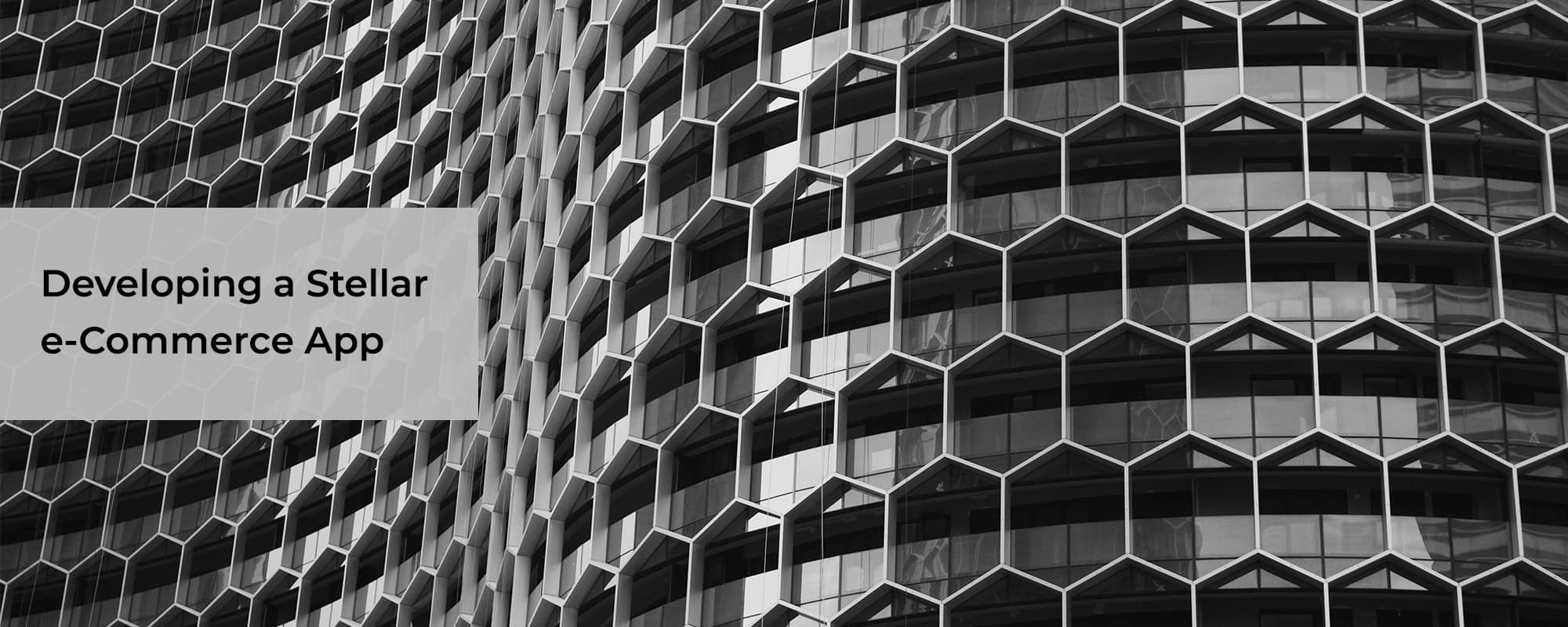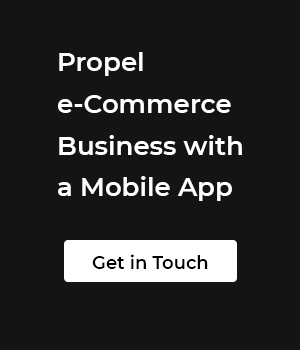Last Updated: 3rd January, 2024
The most common touchpoint today that connects almost everybody, including businesses and consumers seamlessly is the 24-7 connectivity being offered by mobile internet service providers. eCommerce is fast transcending into mobile commerce or mcommerce.
As the usage of mobile phones and devices including tablets and laptops skyrocketed, the business value added with the development of operating system-friendly applications also rose exponentially.
With the most prominent of questions being as to what is the best approach towards developing a robust ecommerce app, this blog will help you with basic considerations that must be kept in mind while deciding to supplement an ecommerce business and website with an app.
Table of Contents
Rationale Behind App Development for eCommerce Businesses
Developing an ecommerce app that can be accessed and operated from about anywhere at any time, is more of an asset necessary for the efficient performance of any business today. With retail mostly happening through mobile and online channels, an application can add immense value to the chain of events that control business transactions.
A look into the statistics also indicate a favorable reasoning for ecommerce app development with nearly 80% of smartphone users making some or the other purchase online. As more and more people are shopping over the internet, it becomes all the more imperative to have a mobile-friendly channel for the sales of commodities.
An analysis into the benefits of ecommerce apps, can further help in the decision making process. Listed below are the advantages of ecommerce apps to businesses:
- Online shopping is the new trend
- Benefits for small and new businesses
- Helps attract customers easily
- It is a competitive advantage
- Helps increase sales
- Everything mobile is the millennial choice
- Enables better customer service
- Allows customization of offerings – easy to build a customer centric business
- Easy analytical analysis of all activities
- Enables contactless payments
- More and improved marketing
- Brand building and propagation is easier
- Customer loyalty is enhanced
Creating an environment where customers are able to get a more personalized and responsive shopping experience is bound to retain them. They will want to re-visit and even recommend the shopping platform or app ahead for perks like loyalty and recommender benefits.
Achieving different business objectives through different types of applications is a significant benefit usually overlooked by business owners. When launching an app can help meet business goals like better UX-UI, leading to better user engagement and increased conversion, understanding what type of an application is needed can be a positive step towards meeting the aim.
In the section ahead, before we address the approach to be taken for an ecommerce app development, we discuss briefly the different types of apps that can be developed, for different business objectives and models.
eCommerce App Types
Smartphones for shopping have driven mobile commerce (mcommerce) to a platform which is proving to be a constant propeller for businesses. The success mantra has brought a new dimension for businesses to draw revenue. Mobile applications have added timeless connectivity for customers. They are now able to access their favorite stores at any time to place their orders.
Based on various models that exist within the businesses, the applications that will support the operations are also different. Developed to fulfill certain business goals and meet objectives, the applications are differentiated based on their features as well as functionalities.
If you are to launch an ecommerce business, there are high chances that you fall in one of these four broad categories:
- Business-to-Business (B2B)
- Business-to-Consumer (B2C)
- Consumer-to-Consumer (C2C)
- Consumer-to-Business (C2B)
There are however other types of models that operate, and there are companies that run on a blend of 2 or even more models.
Depending on the type of transactions expected as part of the business model, wisely choose an app type that allows convenient exchange of commodities and assets over the channel. The application will intend to serve as an important mode of communication between the two parties. Both the seller (offering party) and the buyer (receiving party) must be able to complete their role through the app.
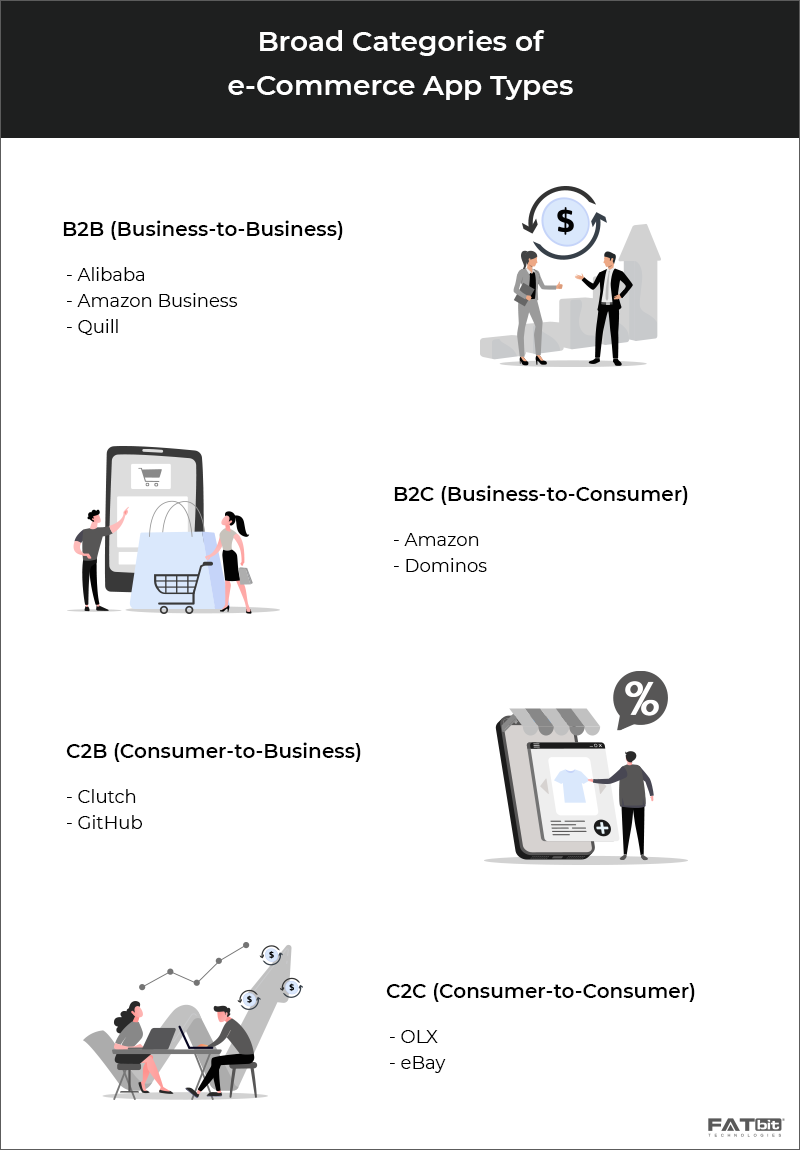
Different types of ecommerce apps, developed to facilitate different activities that will be happening over them, are described here:
1. B2B (Business-to-Business) eCommerce App
Applications capable of enabling business deals over their interface fall into this category. Goods, as well as services, can be exchanged via a mobile channel, catering to big transactions for large quantities of exchange.
Alibaba, Amazon Business, and Quill are examples where industries sell to retailers, who further sell to consumers. So the products sold here can become raw material or items of sale for other industries ahead.
2. B2C (Business-to-Consumer) eCommerce App
The applications developed to supplement a B2C model will consume the company at one end and the end user of the product at the other. Sales happen directly through the application channel. Amazon and Dominos are examples of such ecommerce apps.
Such applications provide the consumer with direct access to all the products being offered by a company, where retailers might limit the stocks and variety when dealing with multiple brands.
3. C2B (Consumer-to-Business) eCommerce App
Businesses are also buyers for niche domain specific offerings like content, design, and technical assets. C2B applications like Clutch and GitHub are a platform for subject matter experts to display their talent and build such business relationships.
Businesses build unique merits on such buys and recommend enhancing the practice of sharing precious talent through such channels.
4. C2C (Consumer-to-Consumer) eCommerce App
When consumers exchange their products, offerings, or services amongst themselves, without the role of any business or company, a C2C type of model functions through a mobile app.
Applications like OLX and eBay, which allow consumers to sell their products to other people like themselves, endorse such sale and purchase, enabling connectivity between a wider user base like the community.
Get eCommerce apps tailored to diverse business models
5. Other application types
Ticketing Booking eCommerce App
These ecommerce apps are to make bookings for cabs, hotels, live shows, games, travel, professional or social events, and parties. The organizers utilize the application to share details of their activity, and interested people avail the facility to buy tickets or passes by paying through the application interface.
Goibibo and Momondo are popular examples of ticket booking applications. Other such ecommerce apps allow an exchange of such commodities between the organizers, event managers, and the end users directly.
eCommerce aggregator App
The mobile applications that build a connection between the end customer and the service providers like Walmart Inc. and Etsy Inc. are aggregator ecommerce apps. They tend to offer a platform to service providers for listing their offerings, items, or products, and buyers can buy or avail them off the application interface.
The application owners themselves do not provide any of the listed services, nor do they need any infrastructural setup, but propagate the services of sellers who join the app for their business.
When developing an ecommerce app, certain components are common across the different types discussed above. These components contribute to the smooth functioning of the application.
eCommerce App developmental Components
eCommerce app Development is a guided process. The objective or business goal to be met decides what all to be included and in what format. But certain elements are common in all ecommerce apps.
Discussed below are those essential components that help build an application for full-circle functions to be performed efficiently.
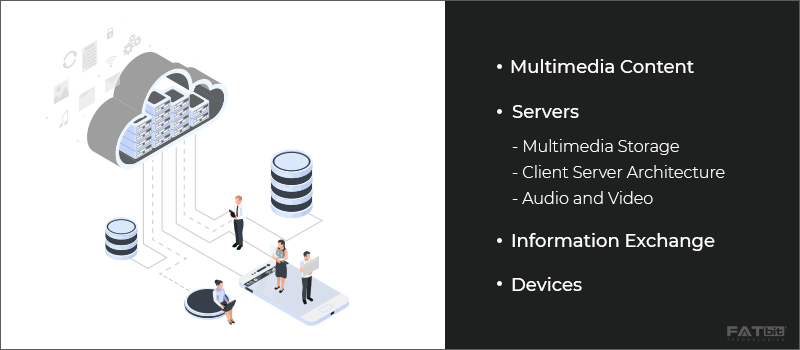
1. Multimedia Content
Different types of content running within an ecommerce app, text, images, videos, graphics, and even audio, that drive the user journeys on the application comprise the multimedia content. They are the main reason a user remains hooked to the app and conducts transactions over it.
Drafted with an effort to imitate interactions between two humans, the content is responsible for generating customer loyalty and conversions on the app.
2. Content Storage Servers
Servers powerful enough to support diverse content in large quantities need to be installed. The digital content is distributed to users and received with important information regarding their details. The servers must be robust, secure, and reliable to cater to the user-base on the app.
a. Multimedia Server Processors
The servers that convert raw data from various media sources into readable information require processors that are reliable and robust. Dealing with data and information that is critical from the user’s perspective, the processor works on it and stores it for all ecommerce apps.
Since these processors handle an excessive amount of data from thousands of users simultaneously using the application, they must be backed with symmetric multiprocessors with parallel processing capabilities. Different forms of data are processed for information exchange through the app interface.
b. Client Server Architecture
The basic architecture of majority of ecommerce apps is centered around message passing between the client/consumer and the server. The format is of a ‘request-response’ type, in the sequence of events taking place.
A user interface is mostly a device that takes the query which is taken care of at the server end. Storage, security, execution, as well as progress, are all happening at the server end of the ecommerce app.
c. Servers for Videos and eCommerce
While developing an application for any ecommerce purpose, it must be kept in mind that various forms of video data will be fed into it, and received from it for various activities. Video servers must be an integral component while planning the development of an ecommerce app.
These servers manage videos for telecommunicating, shopping, advertisements, video chats, and corporate multimedia. They must harbor the capability to deal with planktonic quantities coming in from several thousand users simultaneously.
3. Information Exchange for eCommerce Apps
Information exchange happening over an ecommerce app is majorly utilizing 3 services in coordination with each other:
- Wireless services – managing the cellular, paging, and radio applications
- Telecommunication services – telephonic connectivity, both local and international
- Cable services – handle internet and related services with coaxial, satellite lines, optic fibers, and computer services
These together control the communication channels running over any ecommerce app.
4. Access Devices – Consumer End
The usage of any ecommerce app at the consumer or buyer end is dependent on the execution or end device. Different users use different devices as per their comfort and tasks at hand. Devices can vary from a static personal computer to a television, mobile or smartphones, tablets, smartwatches, voice assistants, and many more.
Their experience also varies as per the device used. The development must be robust enough to give a uniform UX across the different devices.
The basic inclusions when in place, finalizing the features an ecommerce app must have is the next task at hand. Here is a segment that describes the features that must be developed from the MVP stage itself.
Essential Features for eCommerce App Development
Mapping the most important features while developing an ecommerce app is one of the most crucial factors that play a part in the success of the business running over the app. Knowing that people are using mobiles for almost everything they do, the development must take care of integrating maximum convenience while a transaction happens through an ecommerce app.
The chosen feature list will help define the final structure of the ecommerce app development , its design, and the cost of development.
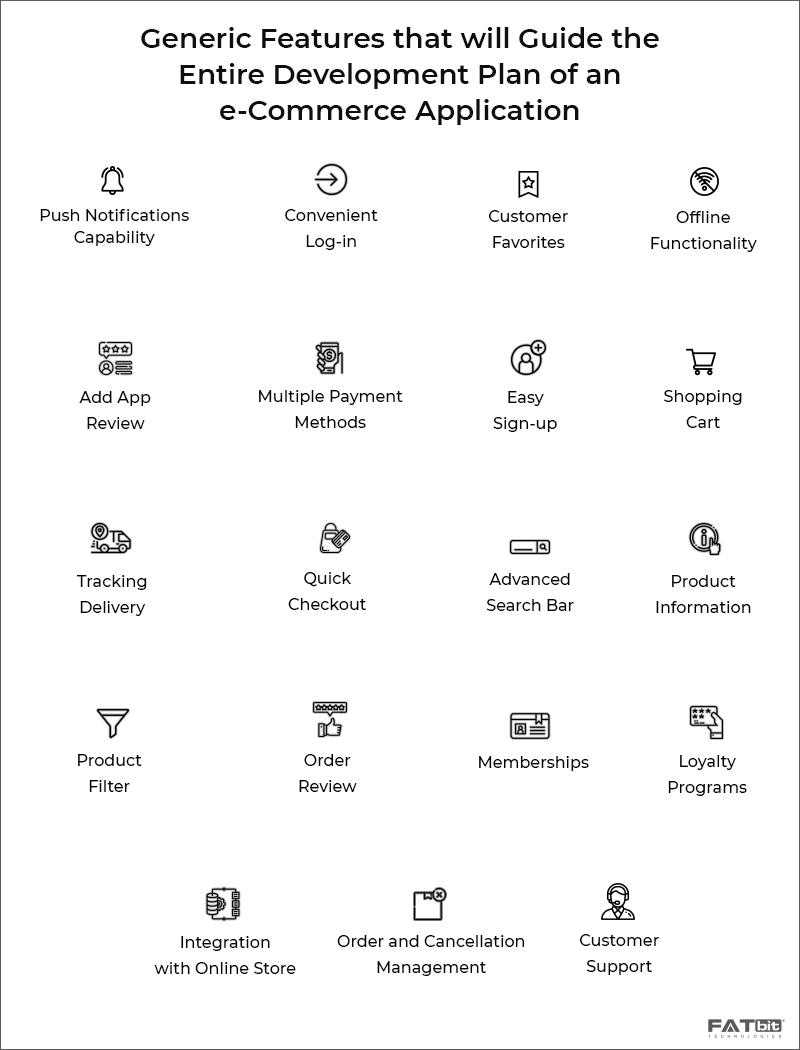
Many features can be added or left out from this list based on the different goals of the ecommerce app being developed. Custom mobile app development is thus always the best approach when deciding to develop an ecommerce app.
Get a Competitive eCommerce App with Stellar Features.
mCommerce Trends In 2024
Chatbots
Customer interaction is key for brands to build engagement with their customers. Communication opens up a channel for interactions 一 making customers feel connected with the brand. Moreover, getting queries answered in a quick time will also help in conversions on the mobile app.
Chatbots foster customer engagement, providing a channel for solving their queries, marketing activities, cross-selling, receiving feedback, and more. Furthermore, customer communication also fosters brand relationships, amplifying brand loyalty.
Additionally, the data received from chatbots also opens up opportunities for businesses to set analysis-driven objectives.
Voice Assistants
In the modern age, the faster your services are the better customer experience you can offer. Voice assistants achieve just that. A faster, intuitive way for the customer to browse and search the website, making them integral to mobile apps of 2024, and beyond.
Big Data
Big Data has started to reshape modern-day business operations. It is a real-time analysis of user interaction across channels, bringing a connected and holistic experience to the customer. The role of Big-Data is maturing as businesses are increasing efforts to get customer attention.
Analysis of how the target audience across demographics and age, engages across channels for a business 一 provides insights into mobile app development for a company. Leveraging Big Data, the UI/UX of the app can be tailored to better meet end-user needs.
Moreover, Big Data can also lead the way for the marketing strategies of a company. With data-driven insights, results can be better achieved.
AR and VR
Augmented reality and Virtual reality aim to enhance user engagement by providing an immersive experience. AR can let users experience virtual objects in real-world scenarios. With the technology, a computer-generated image is superimposed on a real-life live image on devices.
What began with video games like Pokemon Go, has transcended to amplify user experiences in online retail and ecommerce.
eCommerce companies like Amazon, Ikea, and others have leveraged the use of AR technology to let customers experience how products will look in the space they aim to use.
Virtual Reality or VR, on the other hand, leverages the use of technology that simulates a real-world environment in the virtual world. The computer-generated three-dimensional environment gives users the experience of being present there. Some industries that have benefited immensely from VR are fashion, real estate.
VR is best experienced by devices and wearables that support the technology.
Integration of Apps with Wearables
The sale of wearables has been gaining steam for some time now. More companies are rolling out reliable and rich-featured products by the day, giving customers a good range of options to choose from.
According to Market Watch, the sale of wearables increased by at least 25 million units in 2021. The sale of hardware is driving the need for software integration. The importance of integrating mobile apps with wearables is increasing, emphasizing their significance as a key consideration in 2024. It can provide businesses with a competitive advantage in the market.
Geofencing
Geofencing is an integral personalization feature that can let businesses tailor their marketing services based on the location of the customers. Leveraging the technology, they can send notifications on the customers’ app whenever they are near a physical store.
This capability can be used in multiple ways by businesses to gain traction on their products and services. For instance, items in stock, high-demand products, lucrative discount schemes, and other marketing strategies can be used to gain customer attention.
Enhanced Security Measures
The global rise of ecommerce has also led to the evolution of malicious activities. The last decade has witnessed the disruption of payment processes across the ecommerce ecosystems.
Security concerns will keep on increasing as the threat of malicious attacks continues to be on the rise. Data protection also remains a key concern. Vulnerable data is the invitation to catastrophic outcomes.
Moreover, there is still a segment of customers that is reluctant to shop on smaller devices and prefer desktops to mobiles for their transactions.
Enhanced security measures is a not just a trend for 2024, but in all likelihood, a necessity that will be prioritized in the time to come as well.
eCommerce App Development: The Process Simplified
Mobile app development requires inputs from experts from different areas, including a member with subject matter expertise in the area of the ecommerce business for which an app is being developed. Entrepreneurs and new businesses often find themselves at crossroads with questions like:
- What to consider before beginning?
- What type of technology partner to tie up with?
- How much responsibility sharing can be there?
- What all features to develop that are necessary to begin with?
All these questions need to be answered well in time before moving ahead with the app development. Here we share below, in sequence, steps that will help you across the process without any hassle.
Identify App Goals
The success of any ecommerce app is dependent on how efficiently it can meet the business objectives. If what objectives need to be met through the app are unclear, its development will always falter and fail the purpose.
Be specific in laying down set objectives, so as to plan for integrating specific functionalities that need to be developed. The idea should be to collect relevant data through the app, so as to refine the business, with better services and products.
Identify the Audience
Those who will use the ecommerce app will ultimately decide the fate of the business it is supplementing. So, it is imperative to clearly map the user-base and their likes, dislikes, demography, interests, and feedback on the app.
Understanding the nature of the app user will help develop user journeys and stories that leave a lasting impact, and keeps the customer coming back to the app. In the process of identifying the audience for the app and their interests, the niche for the app is also identified. This in a way helps shape the process of ecommerce app development.
Select the Right Technology
As we now understand the users of the app being developed, and the functions it will perform, the next step is to decide what type of an app is needed. For ecommerce, two formats: PWAs and Native apps form the best choices.
- PWAs or Progressive Web Apps are, as the name implies, progressive websites that operate with the agility and performance of a mobile application. The only difference being that they need not be downloaded from play stores, instead need internet connectivity to be accessed through browsers.
PWAs can be the choice in case there is a limitation with regard to the budget, and the traffic on your ecommerce platform is already good.
- Native Apps are regular applications that need to be downloaded from play stores, and need to be developed specifically for operating systems like Android and iOS. The scope to play with the UI-UX in case of Native apps is large, and allows users to experience premium features offered by mobile phones, like access to photos, camera, an interactive interface, and the ability to use the app when offline.
They add to the appeal of the ecommerce store along with allowing immense data on the customer’s behavior and choices to be saved as reference for refining services and products.
Choosing what path to take will depend on the end offering that is made to the customers who choose to visit the eCommerce store. Opting for app development presents opportunities for customization and scalability. Here, you can consider Yo!Kart, a software product by FATbit Technologies that provides readymade, feature-rich mobile apps. Plus, you can also get mobile apps customized to align with your unique concepts, ensuring the delivery of the mobile app of your vision.
Discuss Your eCommerce App Development Needs
Identify Requirements & Features
Moving ahead after deciding what to develop, for whom to develop, and how to develop, it is now time to brainstorm on the features to be included in the ecommerce app. We did identify some must-have features that should be a part of almost every ecommerce app.
The team must give their inputs and suggestions to the development team as to what all should be included as part of the offering to the customers or app users. A business specific feature list prepared after thorough planning needs to be identified.
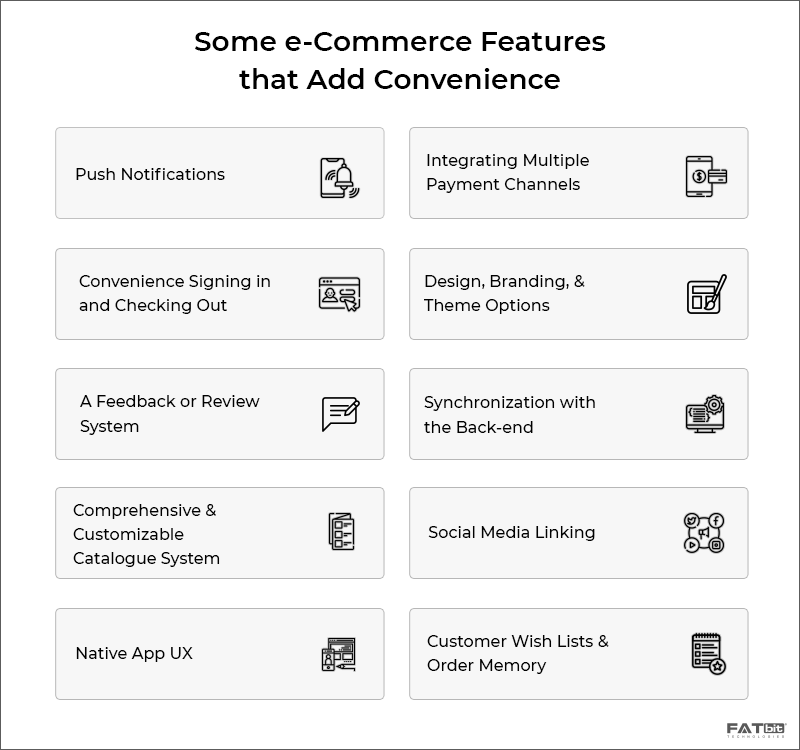
Clarity on the features to be integrated and developed before the actual development of the app begins will help make the app development an efficient exercise.
Process and Budget Planning
Identifying or wanting to include features and functionalities into the ecommerce app is a process that involves much thought, but relating the requirements to the budget is a concern that must not be ignored.
Planning for the integrations and development must take into consideration:
- Whether the app is a bespoke app or a generic app
- Whether a SAAS solution or one-time offering is being developed
- Various pros and cons of each kind of addition to the app
All these points when discussed will help narrowing down to a budget that will be justified towards the type of ecommerce app being developed.
The owners must make sure that even while choosing an agile software development company for the app development, none of the requests must go beyond the budget estimates at any time, to maintain a comfortable business ROI.
Quality Testing and App Release
No matter how robust the development process, and how experienced the brains behind the planning, there are bound to be loopholes. A thorough testing process for load, regression, device, performance, responsiveness, and usability must be a part of standard app development procedures.
After rigorous testing the app is packaged for release onto the play stores. The app must be ideally developed for both iOS and Android play store launch. Make sure there are qualified testers on the team to generate proper quality documents after the testing.
These documents help in building the credibility of the app while releasing it on the play Store.
Marketing the App
Now that the app is released and out for downloading and use, marketing the ecommerce business and the app will help generate business leads.
Use SEO tools and a combination of marketing strategies like content, social media, and loyalty programs to popularize the name of the ecommerce brand. The marketing tools are best utilized if integrated while the app is being developed.
This helps the app or the business owner initialize marketing activities at the launch, growing the business to a scale where a separate marketing team can be built.
These steps will definitely add to the quality and efficiency of the app development process. From here the further objective should be to improvise and develop an app that meets current market standards for quality and technological maturity.
Design an eCommerce App Supplementing and Augmenting the Business Goal
Concluding Remarks
eCommerce businesses today are innovating their customer centricity to a level where they are becoming a part of everyday lives of people. Integrating intelligent features so as to build responsiveness and engagement with buyers has augmented the entire online shopping experience.
The development of an ecommerce app has hence geared up exponentially to keep pace with the consumer demands and expectations. The possibility of receiving an in-store experience with the convenience of being at home has driven the customer to define standards for the ecommerce app developers.
A new businessman in the ecommerce industry will often find himself at the crossroads of figuring out what all to add, build, exclude, and launch for meeting the new consumer in their journey of technological maturity. This blog will help them define a basic flowchart of steps to be taken while developing an ecommerce app for their business.
Most ideally, partnering with technology service providers offering custom mobile app development will serve the best purpose in developing an ecommerce app. More so, connect with software companies where agile development forms their core strength. They will most likely translate the ecommerce business vision into a perfect ecommerce mobile app.
Without a doubt, a good technology partner will help an ecommerce business scale to new heights by developing an engaging mobile application to escalate customer experience. If you are an aspiring entrepreneur or an ecommerce business owner, take a call, and connect with one today.
FAQs
What is an ecommerce app?
An ecommerce app refers to a mobile app with online shopping capabilities. It can be of several types. For example:
- A mobile app that connects users to the online store or marketplace of a business, for example, Amazon and eBay.
- An app to run a standalone mcommerce business where customers can get products or services only via the app and no website exists. Uber is a very popular example of such apps.
As the ecommerce industry is huge, an ecommerce app can be developed for several business niches such as online tutoring, on-demand home services, car rental, furniture rental, food delivery, grocery delivery and more.
How do I develop an ecommerce app?
There are two ways to develop an ecommerce app. The first one is to go for bespoke development where the business owner will need to find a technology partner (such as a software development firm) and state the partner all his/her requirements. The partner will work on the mobile app. This approach is time consuming and often expensive as it includes hourly development prices.
The second approach is to go for a ready-made software. This approach will require none to minimum customization and can be deployed quickly.
What are the basic requirements of an ecommerce app?
The requirements of an ecommerce app vary from business to business. A food delivery app requires a different set of features than a taxi booking app. However, there are still very few features that overlap on the interfaces of many types of ecommerce apps. For example, a search bar, chatbot, and payment gateway.
All ecommerce app development requirements are noted down in an SRS (Software Requirement Specification) sheet and the software development team uses this sheet to develop and test the functionality of the app as per the stated requirements.
What is the cost of developing an ecommerce app?
The cost of developing an ecommerce app varies from company to company and country to country. Below are the average hourly estimates in renowned software development countries:
USA: $50 – $200
Canada: $50 – $150
Mexico: $40 – $120
UK: $50 – $125
Australia: $50 – $125
India: $25 – $100
Philippines: $25 – $75
How long does it take to develop an ecommerce app?
Via custom development, ecommerce apps can take anywhere from 3 months to 12 months to develop. Via a ready-made software (if available for your business type), the same can be done within 1 week to 3 months.
How is an ecommerce mobile app useful for businesses?
Following are some benefits of using an ecommerce mobile app:
- Increased Presence: Via a mobile app, businesses are always remaining within the reach of their customers who don’t even need to open a web browser to shop from your business. They can easily find your app in the menu of their smartphones.
- On the Go Shopping: Mobile phones also enable on the go shopping whereas desktops don’t. If a person is traveling by foot or is far from home, he/she can still browse the ecommerce app and place orders.
- Advanced Marketing: With the help of ecommerce mobile apps, businesses can send push notifications to their customers. Thus, instantly informing them of any offers and discounts.
Brand Recognition: Having an ecommerce app also gives a brand boost and makes the brand stand out. Customers often start recognizing brands after seeing their apps on Android or iOS marketplaces.
